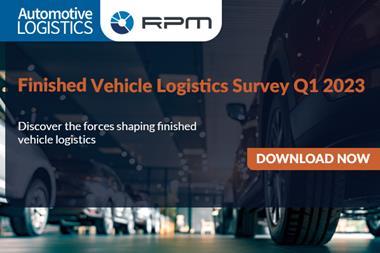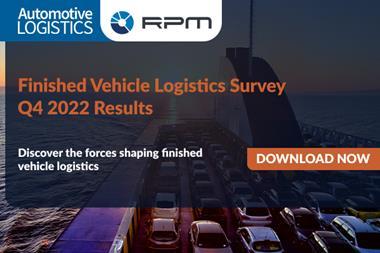Survey questions relating to the latest developments in the finished vehicle logistics sector have now been made live by RPM, in collaboration with Automotive Logistics.
The latest survey builds on two previous quarterly surveys of companies based across Asia, Europe and North America. The results of the last survey showed that volume volatility, labour shortages and capacity constraints were the three main problems affecting the business. That was a distinct change from the concerns expressed in the first survey when rising fuel costs, market uncertainty and vehicle inventory shortages were the main headaches.
The shortage of semiconductors, and of other parts caused by unpunctual container transit and arrival times, continues to have an impact on vehicle manufacturing and the output from the assembly plants has been volatile for some time, as seen in manufacturing performance in the UK. However, over the last quarter there has been some stabilisation in the delivery of containerised goods. At the same time however, there are increased pressures on the finished vehicle sector, with tightened outbound capacity now threatening production, in Europe at least.
In terms of labour, there has not been an adequate return of staff following ‘the Great Resignation’ over the Covid pandemic. That is impacting a finished vehicle sector that already had a significant deficit in numbers and is struggling to make vehicle deliveries on time, at a time when every unit moved is already sold.
That is one aspect of the capacity constraints the finished vehicle sector is feeling, at least on the road network. Haulage equipment may be available but without a driver it is as good as useless. In North America, companies are now more worried about road capacity than they were in the first survey and this is related to having to move bigger and heavier vehicles, including electric ones, within the existing weights and measures regulations. It also remains the top concern in Europe for similar reasons.
Infrastructure investment, charter rates and fuel shortages are also causes for concern in the finished vehicle sector. Respondents in the last survey indicated they were investing in staff benefits and training, improving supply chain monitoring, shopping around for more providers and improving customer service.
This third survey looks into capacity, rates and costs, and labour, and aims to provide an overview of the key trends affecting the sector and how they may have shifted over the quarter as new developments have come to light. You can take part in the survey here and help measure the sentiment of the sector and what are perceived to be the biggest challenges and opportunities out there at the moment.

























![Global[1]](https://d3n5uof8vony13.cloudfront.net/Pictures/web/a/d/s/global1_726550.svgz)














No comments yet